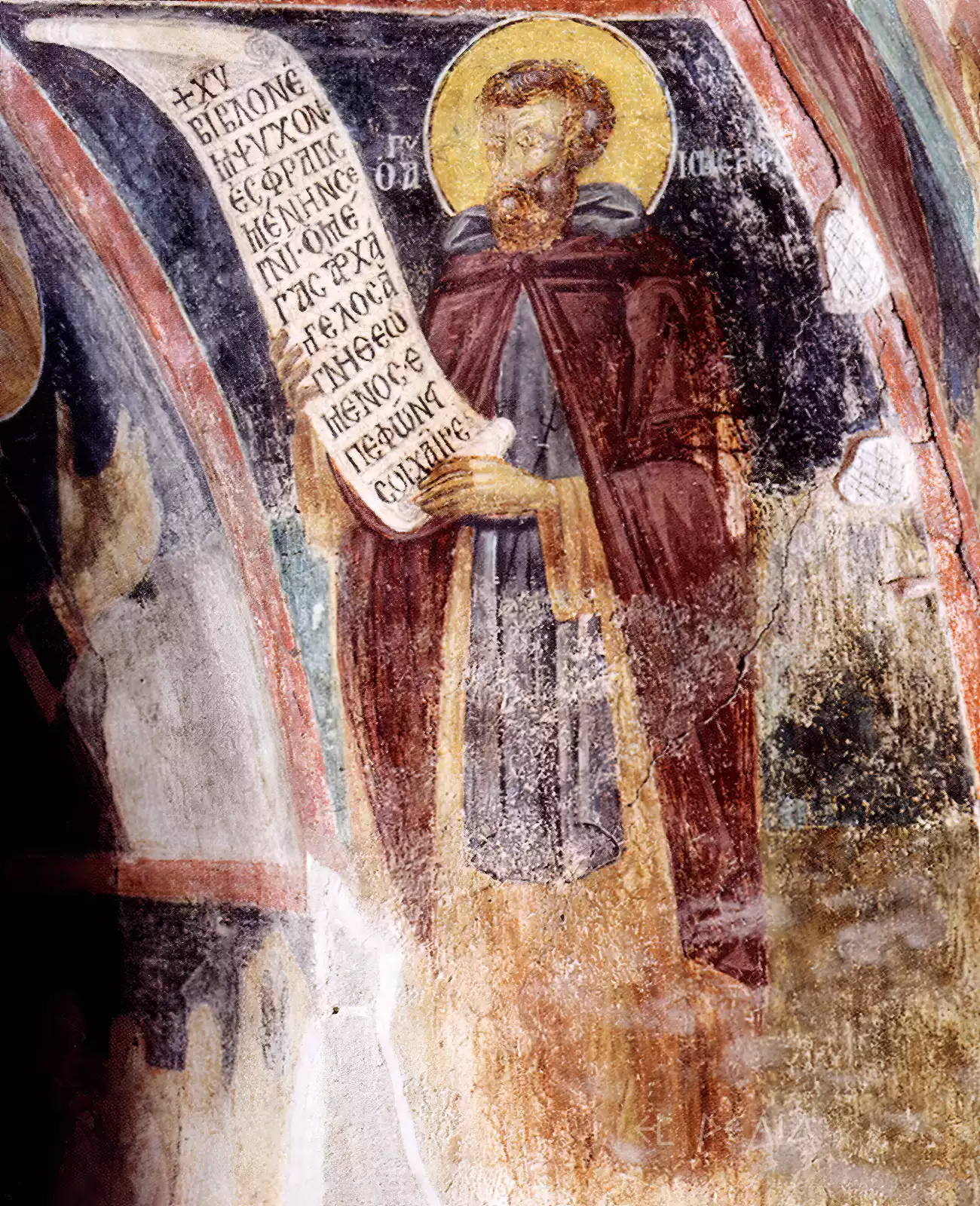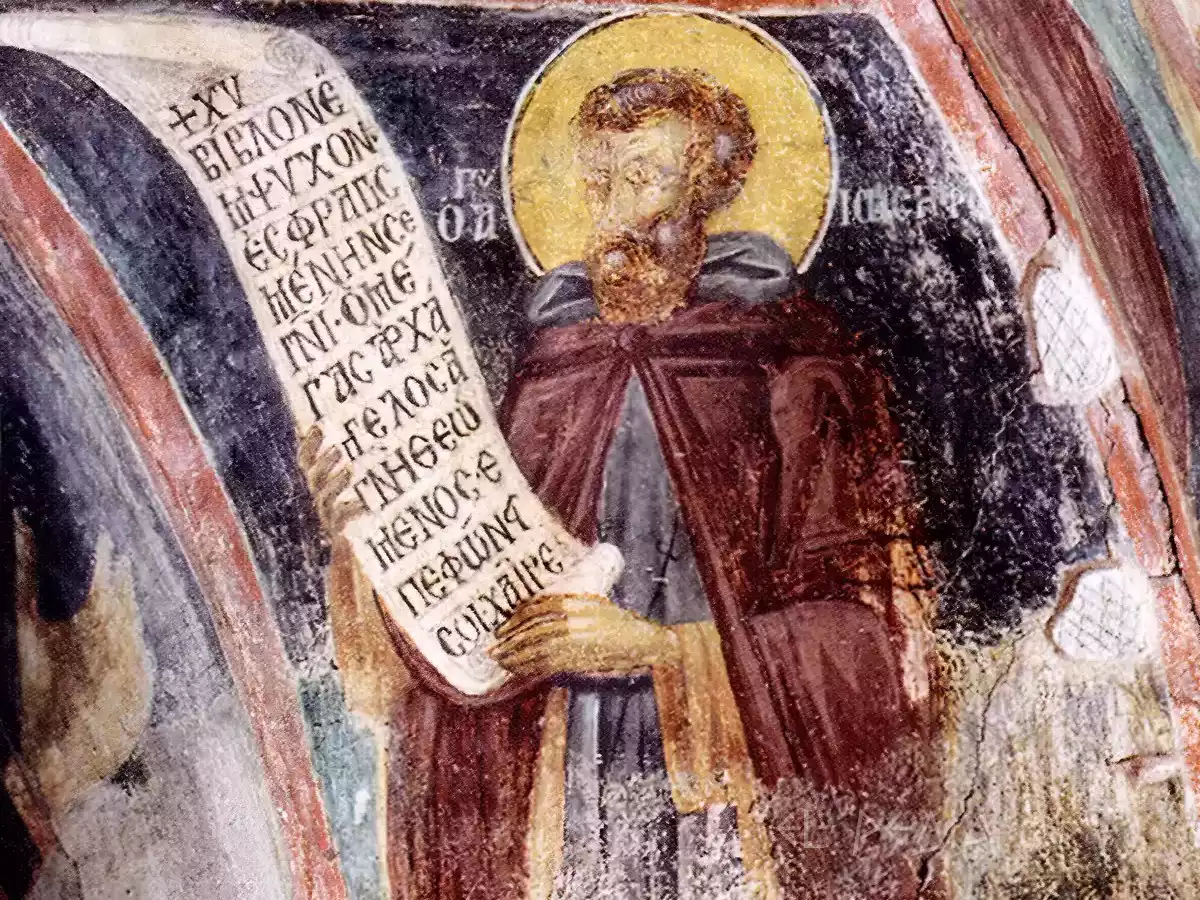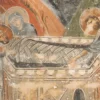
Title: Saint Joseph the Hymnographer
Artist: Unknown
Type: Fresco
Date: Last decades of the 14th century
Dimensions: Unknown
Materials: Fresco on plaster
Location: Holy Monastery of Valsamonero, Church of Panagia Odigitria, Crete
The fresco of Saint Joseph the Hymnographer is an excellent example of late Byzantine art that flourished in Crete during the 14th century. The work is located in the Church of Panagia Odigitria of the Holy Monastery of Valsamonero, an important monastic complex in the Cretan countryside. The fresco depicts the Saint in a characteristic pose, holding an open scroll with Byzantine script, while bearing a halo and wearing Byzantine vestments in deep red color. The style of the work reflects the artistic tradition of Constantinople, adapted to the local Cretan conditions of the time. The dating of the fresco is placed in the last decades of the 14th century, a period of intense artistic activity on the island.
Stylistic Analysis and Artistic Characteristics
The fresco of Saint Joseph the Hymnographer reveals the exceptional technical skill of the artist in the fresco art of the time (D Jiménez-Desmond). The composition is characterized by a particular approach to the use of space, where the figure of the Saint is placed in a strictly organized framework, following the artistic conventions of the late Byzantine period.
The technical execution of the fresco is of great interest, as the artist has used a thicker layer of plaster compared to the overlying scenes, indicating a conscious technical choice to achieve specific artistic results. The color palette, with the dominance of deep red in the Saint’s garments, creates an impressive visual dialogue with the background of the composition.
Particularly noteworthy is the detailed rendering of the Saint’s face and hands, where the artist has demonstrated exceptional skill in depicting anatomical details and tonal gradation, creating a sense of spirituality that characterizes the Byzantine iconographic tradition, while the stylistic analysis reveals the artist’s effort to adapt the scenes to the available curved surface, demonstrating his high technical skill and ability to address the challenges of the architectural space.
The paleographic analysis of the scroll held by the Saint reveals an exceptional calligraphic prowess, with the letters rendered with precision and artistic sensitivity, while the overall composition displays a harmonious balance between its individual elements, with the figure of the Saint fitting perfectly into the available space and the scroll serving as a visual axis that organizes the entire composition.
The technical details of the execution indicate that the artist worked methodically and precisely, applying successive layers of color to achieve the desired result, with the final surface still retaining its vibrancy and brilliance today, despite the wear of time.

Iconographic Tradition and Symbolism
The iconographic tradition of Saint Joseph the Hymnographer at the Valsamonero monastery follows the established rules of Cretan iconography of the time (A Lymberopoulou). The figure of the Saint is rendered with a monumental character, holding the scroll with a Byzantine inscription, an element that underscores his role as a hymnographer of the Church.
The arrangement of architectural elements in the background of the fresco creates a framework that enhances the monumentality of the figure, while the adaptation of the composition to the curved surface of the wall is a characteristic example of the artist’s skill in addressing the challenges of the architectural space, as the scene is harmoniously integrated into the overall iconographic program of the Church of Panagia Odigitria, while maintaining its autonomy as an individual composition.
In the context of iconographic analysis, particular interest is presented by the placement of the fresco in relation to the communication openings towards the nave of the Forerunner, as the dating of the opening of the arched openings near 1400 and before 1407 is an important element for dating the entire decoration, with the depiction of the House Y’ on the southern side of the arch adapting to the surface created above the western communication opening with the new nave.
The composition is characterized by an internal dynamic expressed through the Saint’s posture and his relationship with the scroll he holds, creating a visual dialogue with the viewer and emphasizing the didactic character of the scene, while the use of a thicker layer of plaster compared to the overlying scenes of the Akathist houses indicates a conscious technical choice to achieve specific artistic and symbolic results.
The overall organization of the iconographic program reveals a deep understanding of symbolic associations and the functional needs of the space, with the individual scenes being conceptually connected and creating a unified whole that serves both the aesthetic and spiritual needs of the faithful.
Historical and Artistic Context
The historical context of the creation of the fresco of Saint Joseph the Hymnographer is part of the broader framework of artistic flourishing that Crete experienced during the 14th century. The iconographers of the time shaped a distinct artistic tradition (M CONSTANTOUDAKI). The monastic complex of Valsamonero is a characteristic example of this period.
The dating of the work is placed in the last decades of the 14th century, a period of intense artistic ferment and exchanges between the Byzantine capital and regional centers. The fact that the opening of the arched communication openings with the nave of the Forerunner took place around 1400 and before 1407 provides an important chronological milestone for the study of the overall decoration.
The artistic activity at the Valsamonero monastery reflects the complex processes taking place in Cretan society at the time, as the stylistic analysis of the frescoes reveals the presence of a high-standard workshop that masterfully combined elements of the Constantinopolitan tradition with local artistic trends, creating a unique aesthetic result that characterizes the so-called Cretan school.
The study of the individual elements of the composition, such as the adaptation of the scenes to the architectural space and the use of different layers of plaster, indicates a systematic and well-organized approach to the execution of the decorative program, while the absence of an older painted layer at the points where the openings were made confirms the chronological placement of the work at the end of the 14th century.
This period is characterized by intense artistic activity on the island, with the presence of significant artistic workshops that contributed to the formation of a local artistic tradition, which, while maintaining close ties with Constantinopolitan art, also developed its own distinctive characteristics.
Preserving a Legacy: The Fresco of Saint Joseph the Hymnographer
The fresco that depicts Saint Joseph the Hymnographer is a clear showcase of not only artistic talent but also historical relevance, standing as an important part of the cultural patrimony of the United Kingdom. Wherein lies this fresco’s current condition? One could possibly infer that it tells the story of the fresco’s creation but also of its preservation since that act is what has allowed this artwork to exist in its current state. And while it might prompt a question of “why,” that is likely only relevant for those who might think that maintaining and caring for important works of art does not somehow constitute a meaningful part of preserving local history. But, of course, it is meaningful, and as the fresco serves as a reminder of that, it now additionally can serve as a vessel for the hood of local history.
Efforts to restore the fresco have concentrated on the protection of its delicate painted surface. That must be the case, of course. Yet, I found the next item on the agenda of the restoration team almost astonishing. It was the task of “Assisting the passage of time.” The next goal in the project was to help the fresco “Age gracefully,” to approach its inevitable aging with sufficient fortitude that it will endure longer than many comparable works, especially in light of the recent past. All the while, the fresco’s “delicate painted layer” would be safe and sound.
Present-day restoration work, directed by the tenets of scientific conservation, holds the preservation of an artwork’s authenticity and historical value as its highest priority. When work is needed on a painting’s surface, the conservator likely barely brushes the tool against the surface even as it feels an extraordinary weight of responsibility to ensure that nothing is disturbed—and certainly nothing is added—that would interfere with the original technique or compromise the work’s visual integrity. This approach to conservation would seem to mirror closely the way in which a historical document at the British Library is treated.
It is of the utmost importance to keep a close eye on the condition of the fresco and to make sure that it is not allowed to deteriorate in any way—hence, conservation work on such a delicate object must assume a high degree of caution. “The fresco’s condition is being continuously monitored, and preventive measures are in place,” says Francesca Esposito, a member of the conservation team. “If any potential issues arise, they are resolved swiftly.” It is also essential, of course, to have the right conditions in place for such a delicate object to even stand a chance of not going to seed.
The current state of the fresco highlights how effective the protective measures now in place are. Despite the inevitable passage of time, the fresco has held remarkably true to its original beauty and quality. A continuing commitment to its preservation promises that this precious artistic legacy will long continue to illuminate the path shed by its hardly obscure, if freshly-vanished, figures across British history and culture.
Saint Joseph the Hymnographer in Art
The fresco of Saint Joseph the Hymnographer at the Monastery of Valsamonero is an excellent example of the artistic production of 14th-century Crete. The study of the work highlights its significance as a testament to the cultural and artistic life of the time. The technical perfection, iconographic tradition, and historical significance of the fresco make it an integral part of the Byzantine artistic legacy. The way in which the artist combined traditional Byzantine style with local elements created a work that continues to attract the interest of scholars and inspire contemporary artists. The preservation and study of such works of art are crucial for understanding our cultural heritage.
elpedia.gr
Bibliography
M CONSTANTOUDAKI. “Alexios and Angelos Apokafkos, Constantinopolitan painters in Crete, and the Valsamonero monastery.” Deltion of … (2022).
D Jiménez-Desmond, JS Pozo-Antonio. “The fresco wall painting techniques in the Mediterranean area from Antiquity to the present: A review.” Journal of Cultural Heritage (2024).
A Lymberopoulou. “Post-Byzantine Cretan Icon Painting: Demand and Supply Revisited.” Arts (2023).

